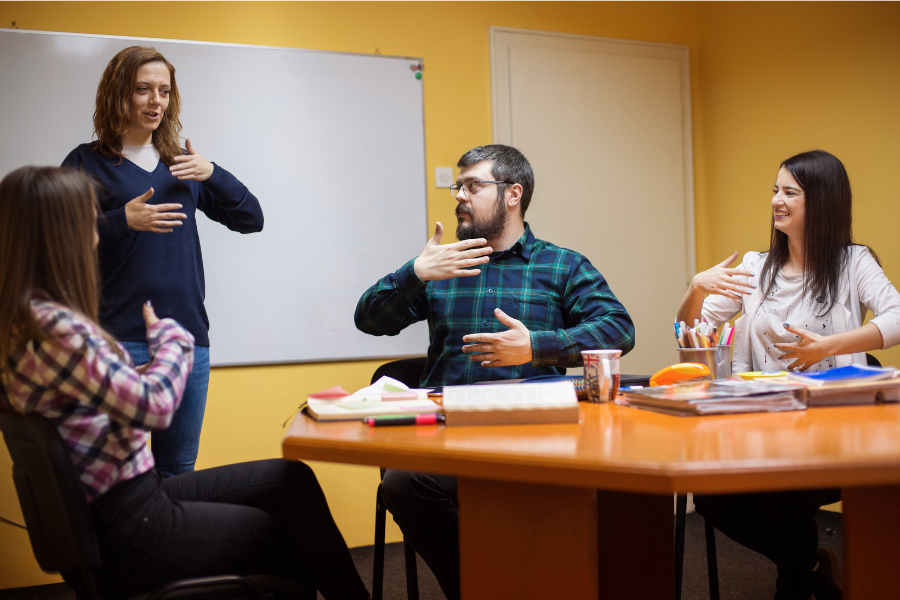7 Powerful Insights on Deaf Gain: Redefining Perceptions
Table of Contents
Introduction
Deaf Gain is a concept that reframes the understanding of deafness from a deficit or loss to a positive and valuable attribute. By shifting to a Deaf Gain perspective, society moves towards greater inclusion, appreciation, and celebration of the diversity and unique abilities that Deaf individuals offer. This change fosters an environment where the contributions of Deaf individuals are recognized and valued. With that in mind, let’s explore some powerful insights into the unique strengths and contributions of the Deaf community.
Redefining Disability: The Concept of Deaf Gain
Traditional Views of Deafness
Traditional views of deafness primarily perceive it as a medical condition characterized by the absence or significant reduction of hearing, emphasizing associated deficits and challenges. This perspective, known as the medical model, focuses on restoring hearing through medical interventions such as hearing aids, cochlear implants, and other auditory technologies. It highlights communication barriers, social isolation, and the economic burden, stressing the challenges Deaf individuals face in a predominantly hearing world and the costs of their integration into mainstream society.
Defining Deaf Gain
Instead of viewing deafness as a medical condition – the traditional view – or disability, Deaf Gain emphasizes the unique strengths, skills, and contributions that Deaf individuals bring to society. This includes enhanced visual and spatial abilities, rich cultural traditions, innovative communication methods, and distinct social perspectives. Deaf Gain advocates for recognizing and celebrating the diversity and capabilities of the Deaf community, promoting inclusion, and valuing the benefits that Deaf individuals offer to the broader world.
1. Redefining Success and Achievement
Deaf Gain emphasizes accomplishments within the Deaf community and beyond, celebrating the richness of Deaf culture, language, and community. Deaf Gain shifts traditional success metrics from integrating into a hearing-centric world to highlighting the unique strengths and contributions of Deaf individuals.
By valuing a Deaf individual’s unique abilities and achievements, Deaf Gain promotes a more inclusive and holistic understanding of achievement.
A Compelling Illustration
Nyle DiMarco is a model, actor, and Deaf activist who gained widespread recognition after winning both “America’s Next Top Model” and “Dancing with the Stars.” He uses his platform to advocate for the Deaf community, promote sign language education, and raise awareness about Deaf culture. DiMarco’s accomplishments highlight the unique strengths and contributions of Deaf individuals, redefining traditional concepts of success and achievement.
2. Cognitive Benefits of Bilingualism in ASL and English
Bilingualism in ASL and English offers significant cognitive benefits, enhancing mental flexibility, problem-solving skills, and executive function. The use of both visual-spatial and auditory-verbal processing strengthens neural connections, fostering improved memory and cognitive agility. This aspect of Deaf Gain enriches social interactions and equips individuals with a robust cognitive toolkit for diverse environments.
A Compelling Illustration
Maria Coppola’s research on bilingualism in Deaf individuals highlights the cognitive and linguistic benefits of learning both ASL and English. Her studies show that bilingual education for Deaf children fosters strong language skills in both ASL and English, supporting academic and cognitive growth. This aligns with broader research, indicating that a strong foundation in both languages leads to better educational outcomes, higher literacy rates, and improved cognitive abilities.
3. Innovation and Creativity Stemming from Deaf Gain
Deaf Gain fosters creativity and innovation by leveraging the unique experiences of Deaf individuals, especially in technology and the arts. In technology, innovations such as video relay services and captioning tools, promote Deaf Gain as well as benefit society at large. In the arts, enhanced visual and spatial awareness among Deaf artists leads to groundbreaking theater, dance, and visual arts. By valuing these distinct capabilities, Deaf Gain drives advancements that enrich technological and diversify cultural landscapes.
A Compelling Illustration
Dr. Raja Kushalnagar is a Professor and Director of the Information Technology program at Gallaudet University. His research focuses on the intersection of disability law, accessible and educational technology, and human-computer interaction, with a specific emphasis on improving information access for deaf and hard-of-hearing individuals. Raja advocates for advancements in accessible computing, including automatic captioning and subtitling, and works to bridge gaps between consumers, industry, and policymakers on accessibility issues.
4. Enhanced Visual and Spatial Awareness
Deaf individuals often possess heightened visual and spatial awareness due to the brain’s adaptation to the absence of auditory input. This increased reliance on sight enhances their ability to notice visual details and changes in their environment, excelling in tasks requiring peripheral vision and spatial memory. These strengths prove valuable in architecture and design where visual and spatial skills are paramount. By leveraging these capabilities, Deaf Gain highlights the unique contributions of Deaf individuals, challenging traditional views of deafness as merely a deficit.
A Compelling Illustration
Chris Laing is a trailblazing Deaf architect renowned for his innovative designs that seamlessly blend accessibility, functionality, and aesthetic appeal. Leveraging his heightened visual and spatial awareness, Chris creates inclusive spaces that cater to diverse needs, emphasizing visual communication and intuitive navigation. His work challenges traditional design notions and highlights the powerful impact of Deaf Gain in architecture.
5. Inclusive Communication Strategies Benefiting All
Inclusive communication strategies in the Deaf community benefit everyone by enhancing clear, accessible, and respectful interactions. Unique cultural practices like visual signals, tactile feedback, and maintaining eye contact improve communication efficiency. Traditions such as Deaf storytelling and social gatherings emphasize shared experiences and understanding, fostering strong community bonds. These strategies ensure that everyone’s voice is heard, promoting mutual respect and understanding in broader society.
A Compelling Illustration
Ben Bahan is a renowned Deaf storyteller, educator, and advocate celebrated for his influential work in Deaf literature and culture. Through his innovative storytelling techniques, he captures the essence of Deaf experiences and promotes the rich cultural heritage of the Deaf community. Bahan’s dedication to preserving and sharing Deaf narratives has made a significant impact on both Deaf education and the broader understanding of Deaf culture.
6. Richness of Deaf Culture and Community
Deaf culture offers a unique blend of traditions and social structures that foster a strong sense of identity and belonging. ASL is a key aspect, serving as both a communication tool and a means of cultural expression. Storytelling traditions within the Deaf community help preserve history and values, while social networks emphasize mutual support and advocacy, highlighting the importance of recognizing and appreciating Deaf culture as an integral part of society.
A Compelling Illustration
George Veditz was an early 20th-century educator and advocate who dedicated his life to preserving ASL and promoting Deaf rights. As the seventh president of the National Association of the Deaf (NAD), he is best known for his 1913 film “The Preservation of Sign Language,” where he emphasized the importance of ASL and the cultural heritage of the Deaf community. Veditz’s pioneering work in documenting ASL has had a lasting impact, showcasing the deep sense of identity, pride, and resilience within the Deaf community.
7. Strengthened Social Bonds and Community Support
Deaf Gain highlights the enriched social bonds and strong community support within the Deaf community. The shared experiences of navigating a hearing-centric world foster close-knit relationships and a robust support network. These social structures promote resilience, collective identity, and mutual assistance, emphasizing the strength and unity of the Deaf community. By valuing these social connections, Deaf Gain showcases how these unique bonds enhance personal and communal well-being.
A Compelling Illustration
Claudia Gordon is a Deaf community activist and advocate for disability rights, becoming the first Deaf African American woman to earn a law degree. She has held influential roles in the U.S. Department of Labor and the White House, working to eliminate barriers and promote equal opportunities for the Deaf and disabled communities. Claudia’s dedication to advocacy and policy change strengthens social bonds within the Deaf community.
Conclusion
In this post, we’ve explored seven powerful insights on Deaf Gain, highlighting how it redefines traditional views of deafness by celebrating the unique strengths and contributions of Deaf individuals. From cognitive benefits of bilingualism to enriched social bonds and community support, Deaf Gain offers a holistic understanding of achievement and inclusion.

Call to Action
Share your thoughts and join in the conversation! How have you experienced or witnessed the benefits of Deaf Gain in your own life or community, and how do you think it can be better integrated into mainstream society?






Because of IDEA I , as an able-bodied person who is aging, have a less frustrating life because of close captions a result of Deaf Gain.
Thank you for your comment! That is just one of numerous societal benefits resulting from such laws.